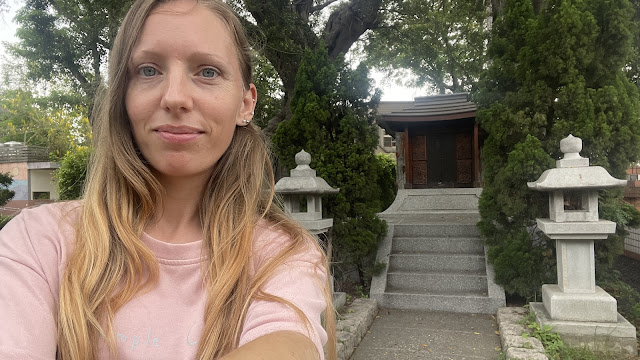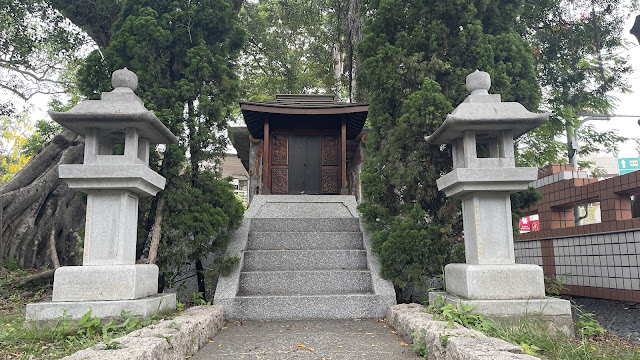Travel date: 2024/05/18
While traveling to Tainan City, we made stops to visit some places along the way. Unfortunately, the weather wasn't favorable, with occasional clouds and rain. Our first stop was Yizhu Village in Chiayi, a small village bordering Yanshui District of Tainan, where we also visited afterward.
I had found a beautifully looking house on Google Maps, and according to the website and reviews, it was supposed to be open for visits on weekends. However, it was closed when we arrived, which was disappointing as the house appeared very intriguing. Additionally, neighbors warned us about the presence of aggressive dogs inside, advising against entering on our own. With no doorbell or information available, and hearing from others that they ventured inside cautiously due to the dogs, we decided to abandon the idea. Despite being recognized as a historical building, Wengqingjiang Ancient House isn't inaccessible to the public.
Later, we explored another ancient building in the area, Yizhu Cunde Hall. Though perhaps not as visually striking as the first house, it housed numerous memorials from a former President of the Judicial Yuan. The owner graciously provided us with a tour, showcasing the memorials, and even escorted us to another ancestral building nearby. Despite its state of ruin, the building was captivating to explore, and the weather added to the atmosphere of the ancient remains. It's regrettable to think that many of these antique details, not commonly seen in modern houses, may vanish with time.
We also made a brief stop in Yanshui District, where we visited two places we had missed on previous visits. The first was Yanshui Train Station, an old station once part of the Sugar Factory, and the remains of a Japanese Shrine located on the grounds of a local elementary school.
I've visited several remnants of Japanese Shrines lately. It's interesting, considering I had never harbored a desire to visit Japan, yet I appreciate Japanese architecture in Taiwan. I understand this might be a sensitive topic, as some people may have negative sentiments towards Japan due to historical reasons, but it remains a part of Taiwan's history.
For more details on the places we visited in Chiayi, please refer to my other post LINK
Yanshui Railway Station (鹽水小火車站)
The Kanai Sugar Factory in Yanshui Town, established in 1903, utilized the Yanshui Small Railway Station (a five-minute train ride) for transporting sugar cane and sugar packets. This railway station, the first of its kind in Taiwan's sugar railway history, facilitated passenger transportation between Xinyingzhuang and Yanyan Port starting from May 20, 1909 during the Japanese colonial period. It was the inaugural operating line in the history of Taiwan's Sugar Railway, serving as a crucial transportation link for students commuting to school in Yanyan Town.
The sugar factory suffered bombing damage at the end of World War II, leaving the entire facility in ruins. However, the Yanshui Small Railway Station, renovated during Taiwan's liberation period, retains its original appearance, including remnants of the station warehouse.
The old train station outside the gate of the Kanai Sugar Factory once served as a rest stop for sugarcane farmers, meeting place for workers, and gathering spot for sugar transporters. However, it was demolished post-liberation, erasing a significant piece of local history.
Railway Lines:
- Taiwan Sugar Railway’s First Raw Material Line: Established from 1906 to 1907 at the Qiaotou Factory, this 30-inch (762 mm) light railway transported sugar cane, marking Taiwan Sugar Railway's initial raw material line.
- First Business Line of Taiwan Sugar Railway: The first business line, known as the Budai Line, opened in 1909, providing passenger and cargo transportation services outside the sugar factory. Initially, only Xinying and Yanyan Port stations were established.
- Japanese Era Railway Lines: On May 20, 1909 (Meiji 42), the five-mile-and-three-mile stretch between Xinyingzhuang and Yanyan Port commenced operations as Taiwan's first regular sugar railway line.
- Taiwan's Railway Lines: The post-war period witnessed changes to the railway lines, including station relocations and renovations. The Bag Line underwent several modifications, accommodating shifts in public demand and urban development.
Yanshui Elementary School Shrine (鹽水神社)
The Yanshui Elementary School Shrine, located within the premises of Yanshui Elementary School in Tainan City, was designated as a historical building on March 18, 2005. Constructed towards the end of the Japanese colonial period in Taiwan, this shrine follows the structural design of a Wuge shrine, with its deity believed to be Amaterasu. Initially, following World War II, the shrine underwent transformation into "Dachengden," where rituals honoring Confucius were conducted. However, it wasn't until 1973, during the Chinese Cultural Revival Movement, that fresh graduates were required to pay homage here before graduation. The building was restored to its original shrine appearance on June 25, 2008.
The roots of Yanshui Elementary School can be traced back to the establishment of the "Chiayi Mandarin Institute Yanyan Port Branch" in 1898, later renamed as "Yanyan Public School" in 1921. Over the years, it underwent several name changes, eventually becoming Yanshui Elementary School. The shrine was erected in 1940, during which it served as a significant spot for students to visit and offer prayers, as well as for graduation photoshoots.
Post-World War II, like many shrines across Taiwan, renovations altered its purpose. It was converted into a Confucius Temple during Principal Chen Gengtan's tenure, although no ceremonies were held. However, in response to the Chinese Cultural Renaissance Movement, fresh graduates were mandated to pay tribute here before graduation. To address the building's dilapidation, the Tainan County Government convened a meeting in 2007 to determine the restoration direction. The project, completed in 2008, aimed to restore the shrine's original appearance while preserving the Confucius Temple building as much as possible.
The shrine faces east to west and comprises a torii gate, stone lantern, and main shrine. Its design resembles that of Harukasaiden Hall and Marijuana Bōsaiden Hall, albeit with a simplified layout. The torii gate, known as the "Kami torii gate," features straight beams. Following the war, the torii gates and stone lanterns were removed, and the main hall was painted red and blue, with a tiled base. After restoration, the main hall's rain-drained panels were stripped of paint, and carved decorations of the Three Friends of Suihan and the Fish Leaping Dragon Gate were added. Monuments were relocated to the campus flower garden and activity center upon completion.
Address:
1. Yanshui Train Station: 737台南市鹽水區治水路與文武街交叉口
2. Yanshui Shrine: 737台南市鹽水區朝琴路137號
%202.jpg)




















0 komentarze:
Post a Comment